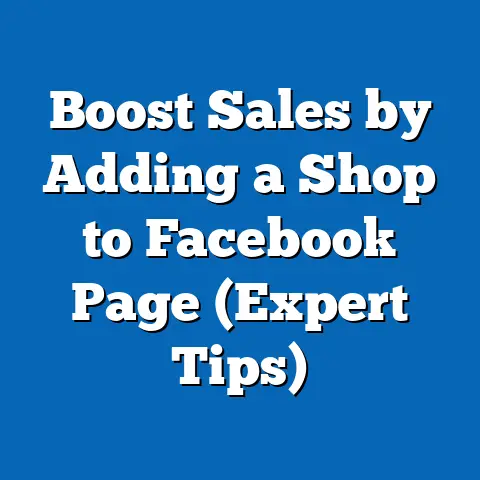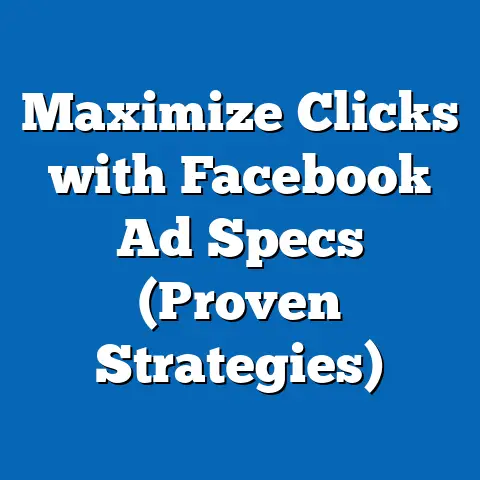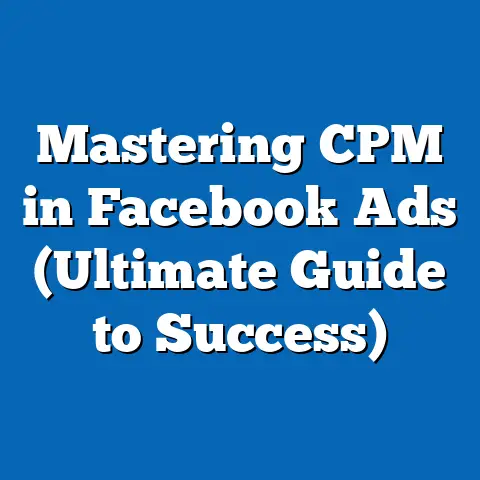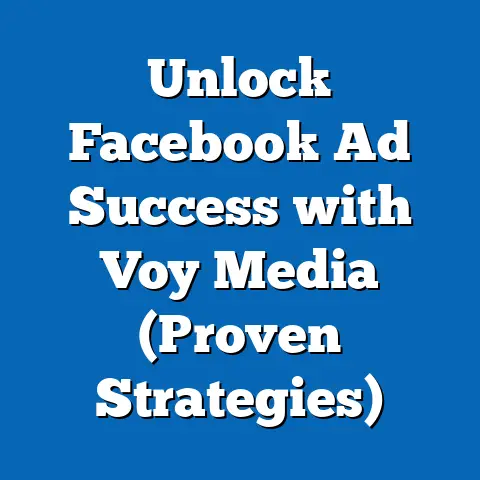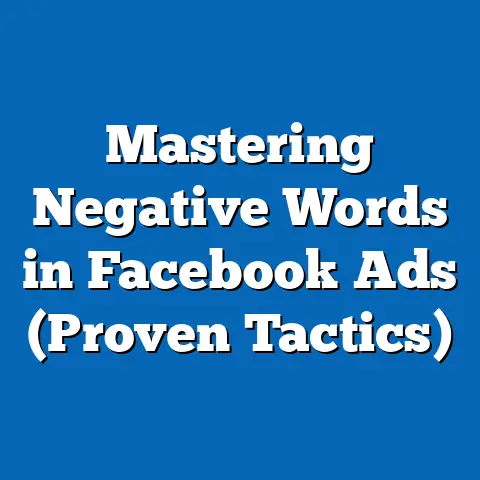Mastering Facebook Ad Limitations (Unlock Secret Strategies)
Imagine trying to capture the vibrant hues of a sunset on canvas. You’ve got a palette full of colors – each representing a different Facebook ad strategy – but some shades just don’t mix quite right. That’s the reality of Facebook advertising. It’s powerful, yes, but riddled with limitations that can make even the most seasoned marketers scratch their heads. We’re talking about budget constraints that feel like painting with watercolors instead of oils, audience targeting that sometimes resembles throwing darts in the dark, the dreaded ad fatigue that can turn your masterpiece into a monotonous blur, and the ever-shifting algorithms that redraw the landscape overnight.
I’ve been in the trenches of Facebook advertising for years, and I’ve seen firsthand how these limitations can cripple campaigns. But here’s the secret: understanding these constraints isn’t a roadblock; it’s the key to unlocking truly effective strategies. It’s about learning to work within the system, not against it. It’s about transforming those perceived weaknesses into strengths. In this guide, I’m going to share the strategies I’ve personally used to not just survive, but thrive, in the ever-evolving world of Facebook ads. We’ll dive deep into practical techniques, real-world examples, and actionable tips that will help you turn limitations into opportunities and unlock the full potential of your Facebook ad campaigns.
Understanding Facebook Ad Limitations
Before we can conquer these challenges, we need to understand them intimately. Facebook advertising, while incredibly powerful, isn’t a magic bullet. It comes with its own set of inherent limitations that can significantly impact your campaign’s success. Let’s break down the most common culprits:
Budget Constraints: The Tightrope Walk
One of the most frequent hurdles I see marketers face is the dreaded budget constraint. It’s the feeling of wanting to reach a vast audience but being stuck with a shoestring budget. This limitation manifests in several ways:
- Limited Reach: A small budget naturally restricts the number of people you can reach. You might be targeting the perfect audience, but if your budget is too low, your ad won’t be seen by enough of them.
- Reduced Frequency: Frequency refers to how often your target audience sees your ad. With a limited budget, you might not be able to show your ad frequently enough to make a lasting impression.
- Delayed Results: Patience is a virtue, but with a smaller budget, you’ll need even more of it. Results might take longer to materialize as you’re essentially stretching your resources thin.
Example: I once worked with a small local bakery that wanted to promote their new line of artisanal breads. Their initial budget was a mere $5 per day. While we managed to generate some awareness, the limited reach meant that very few people actually visited the bakery.
Audience Targeting: The Needle in a Haystack
Facebook’s targeting options are incredibly granular, which can be both a blessing and a curse. While you can theoretically target incredibly specific demographics and interests, finding the right audience can feel like searching for a needle in a haystack.
- Overlapping Audiences: It’s easy to create multiple audiences that overlap significantly, leading to ad spend being wasted on the same users.
- Incorrect Assumptions: We often make assumptions about our target audience that turn out to be wrong. This can lead to targeting the wrong people entirely.
- Audience Saturation: Even with precise targeting, you can eventually saturate your audience, leading to ad fatigue and declining performance.
Example: I remember a campaign for a fitness app where we initially targeted people interested in “fitness” and “healthy eating.” However, we quickly realized that this audience was too broad. We needed to refine our targeting to focus on specific types of fitness activities, like yoga or running, to see better results.
Ad Fatigue: The Law of Diminishing Returns
Ad fatigue is a phenomenon where your audience becomes desensitized to your ads after seeing them repeatedly. It’s like hearing the same song on repeat – eventually, you tune it out.
- Decreased Engagement: As ad fatigue sets in, you’ll notice a decline in engagement metrics like click-through rates (CTR) and conversions.
- Negative Brand Perception: Overexposure can even lead to a negative perception of your brand, as people become annoyed by the constant barrage of ads.
- Wasted Ad Spend: Continuing to run ads that are suffering from fatigue is simply throwing money down the drain.
Example: I once ran a campaign for an e-commerce store that was promoting a limited-time sale. The ads were highly effective initially, but after a few weeks, we saw a sharp decline in performance. We realized that we had overexposed our audience and needed to refresh our creatives.
Algorithm Changes: The Shifting Sands
Facebook’s algorithm is constantly evolving, and these changes can have a significant impact on your ad performance. What worked yesterday might not work today.
- Decreased Organic Reach: Facebook has consistently prioritized content from friends and family over business pages, making it harder to reach your audience organically.
- Increased Competition: As more businesses flock to Facebook advertising, competition for ad space increases, driving up costs.
- Unpredictable Performance: Algorithm changes can lead to unpredictable fluctuations in ad performance, making it difficult to forecast results.
Example: I recall when Facebook introduced a major algorithm update that prioritized “meaningful interactions.” This meant that ads that encouraged conversations and engagement were favored over those that simply pushed products. We had to completely revamp our ad strategy to adapt to this change.
Takeaway: Understanding these limitations is the first step towards overcoming them. Each challenge requires a unique approach, and the strategies we’ll explore in the following sections will help you navigate these hurdles with confidence.
Strategies to Overcome Budget Constraints
So, you’re staring down the barrel of a limited budget. Don’t despair! This isn’t a death sentence for your Facebook ad campaign. In fact, it can force you to be more creative, strategic, and resourceful. Here are some of my go-to strategies for maximizing ad performance on a tight budget:
Utilizing A/B Testing: The Scientific Approach
A/B testing, also known as split testing, is the process of comparing two versions of your ad to see which one performs better. This is crucial when you’re on a budget because it allows you to identify the most effective ad creatives and avoid wasting spend on underperforming ones.
- Test One Element at a Time: To get meaningful results, test only one element at a time. This could be the headline, the image, the call-to-action, or the targeting parameters.
- Use Small Budgets for Testing: You don’t need a huge budget to run A/B tests. Even a few dollars per day can provide valuable insights.
- Analyze the Results: Pay close attention to metrics like CTR, conversion rate, and cost per acquisition (CPA) to determine which version is the winner.
Example: I once ran an A/B test for a local restaurant that was promoting a new lunch special. We tested two different images: one featuring a close-up of the dish and another showing people enjoying the meal in the restaurant. The image with the people enjoying the meal performed significantly better, leading to a higher CTR and more reservations.
Leveraging Organic Reach: The Power of Community
While Facebook has significantly reduced organic reach, it’s not dead. Integrating organic content into your strategy can complement your paid ads and enhance overall performance.
- Create Engaging Content: Share valuable, informative, and entertaining content that resonates with your target audience.
- Encourage Interaction: Ask questions, run polls, and encourage comments to foster a sense of community.
- Promote Your Page: Run ads to promote your Facebook page and build a larger following.
Example: I worked with a non-profit organization that was struggling to reach its target audience with paid ads. We started creating engaging organic content, including blog posts, videos, and infographics. This not only increased their organic reach but also improved the performance of their paid ads, as people were more likely to engage with a brand they already knew and trusted.
Tapping into Lookalike Audiences: Cloning Your Success
Lookalike Audiences are one of Facebook’s most powerful targeting tools. They allow you to reach new people who are similar to your existing customers or website visitors. This is a great way to expand your reach without significantly increasing your costs.
- Start with Your Best Customers: Use your customer list or website data to create a seed audience of your most valuable customers.
- Choose the Right Similarity: Facebook allows you to choose how similar the lookalike audience should be to your seed audience. Start with a smaller percentage (e.g., 1%) for more precise targeting.
- Test Different Lookalike Audiences: Experiment with different seed audiences and similarity percentages to find the ones that perform best.
Example: I helped an e-commerce store that was selling handmade jewelry create a lookalike audience based on their existing customer list. This lookalike audience performed significantly better than their previous targeting efforts, leading to a lower CPA and a higher return on ad spend (ROAS).
Takeaway: Budget constraints can be a blessing in disguise. By focusing on A/B testing, leveraging organic reach, and tapping into lookalike audiences, you can maximize your ad performance and achieve your goals without breaking the bank.
Navigating Audience Targeting Challenges
Targeting the right audience is paramount to the success of any Facebook ad campaign. But with so many options available, it’s easy to get lost in the weeds. Here’s how to navigate those challenges and ensure your ads are reaching the people who are most likely to convert:
Segmentation Strategies: Divide and Conquer
Instead of targeting one large, generic audience, segment your audience based on demographics, interests, and behaviors. This allows you to create tailored ads that resonate with specific groups of people.
- Demographic Segmentation: Target people based on age, gender, location, education, and other demographic factors.
- Interest-Based Segmentation: Target people based on their interests, hobbies, and passions.
- Behavioral Segmentation: Target people based on their online behavior, such as purchase history, website visits, and app usage.
Example: I worked with a travel agency that was promoting a luxury vacation package. Instead of targeting everyone interested in travel, we segmented our audience based on income, travel preferences, and past travel behavior. This allowed us to create ads that spoke directly to the desires and needs of each segment.
Retargeting Strategies: Second Chances
Retargeting allows you to show ads to people who have previously interacted with your brand, such as visiting your website, watching a video, or engaging with your Facebook page. This is a highly effective way to re-engage potential customers and drive conversions.
- Website Retargeting: Show ads to people who have visited specific pages on your website.
- Video Retargeting: Show ads to people who have watched a certain percentage of your videos.
- Engagement Retargeting: Show ads to people who have liked, commented on, or shared your Facebook posts.
Example: I helped an online clothing store implement a retargeting campaign that showed ads to people who had added items to their cart but didn’t complete the purchase. This resulted in a significant increase in sales, as we were able to remind potential customers about the items they had left behind.
Using Custom Audiences: The Personal Touch
Custom Audiences allow you to upload your own customer lists, website data, or app data to Facebook and create highly targeted audiences. This is a powerful way to reach your existing customers or find new customers who are similar to them.
- Customer List Upload: Upload your customer list to Facebook and target your existing customers with special offers or promotions.
- Website Traffic Custom Audience: Create an audience of people who have visited your website.
- App Activity Custom Audience: Create an audience of people who have used your mobile app.
Example: I assisted a software company in creating a custom audience based on their existing customer list. They then used this audience to promote a new product feature to their most loyal users. This resulted in a high adoption rate and positive feedback.
Takeaway: Overcoming audience targeting challenges requires a strategic approach. By segmenting your audience, leveraging retargeting, and using custom audiences, you can ensure that your ads are reaching the right people and driving the desired results.
Combatting Ad Fatigue
Ad fatigue is a common problem that can derail even the most well-crafted Facebook ad campaigns. But don’t worry, there are several ways to keep your content fresh and engaging and prevent your audience from tuning you out.
Creative Variations: The Spice of Life
The simplest and most effective way to combat ad fatigue is to regularly update your ad creatives, including visuals and copy.
- Rotate Images and Videos: Use different images and videos to keep your ads visually appealing.
- Experiment with Headlines and Body Text: Test different headlines and body text to see what resonates with your audience.
- Highlight Different Benefits: Focus on different benefits of your product or service in each ad.
Example: I worked with a subscription box company that was promoting their monthly box. Instead of using the same image of the box in every ad, we rotated different images showcasing the individual products inside. This kept the ads fresh and engaging and prevented ad fatigue.
Implementing Dynamic Ads: The Personalized Experience
Dynamic ads automatically showcase relevant products to users based on their behavior, such as browsing history or past purchases. This is a great way to personalize the ad experience and keep your audience engaged.
- Upload Your Product Catalog: Upload your product catalog to Facebook and let the platform automatically generate ads based on user behavior.
- Use Retargeting: Show dynamic ads to people who have viewed specific products on your website.
- Promote Cross-Sells and Upsells: Use dynamic ads to promote related products or higher-priced versions of products that users have already purchased.
Example: I helped an e-commerce store that was selling furniture implement dynamic ads. The ads showed users the specific pieces of furniture they had viewed on the website, along with related items. This resulted in a significant increase in sales, as we were able to provide a personalized and relevant ad experience.
Engaging Content Formats: Beyond the Image
Don’t limit yourself to static images and text. Explore alternative ad formats that can capture attention and keep your audience engaged.
- Video Ads: Video ads are highly engaging and can be used to tell a story or showcase your product in action.
- Carousel Ads: Carousel ads allow you to showcase multiple images or videos in a single ad.
- Collection Ads: Collection ads allow you to showcase a catalog of products in a visually appealing format.
- Instant Experiences: Instant Experiences are full-screen, interactive ads that can be used to create a more immersive ad experience.
- Playable Ads: Playable ads are interactive ads that allow users to try out a game or app before downloading it.
- Interactive Polls and Quizzes: These formats are fantastic for driving engagement and gathering valuable insights about your audience.
Example: I assisted a local brewery in creating a video ad that told the story of their brewery and their passion for craft beer. This video ad resonated with their target audience and resulted in a significant increase in brand awareness and sales.
Takeaway: Combatting ad fatigue requires a proactive approach. By regularly updating your creatives, implementing dynamic ads, and exploring engaging content formats, you can keep your audience interested and prevent your ads from becoming stale.
Adapting to Algorithm Changes
Facebook’s algorithm is a constantly moving target. What works today might not work tomorrow. To stay ahead of the curve, you need to be adaptable, informed, and data-driven.
Staying Informed: The Knowledge Advantage
The first step to adapting to algorithm changes is to stay informed. Follow Facebook’s official blog, industry news sources, and expert opinions to stay up-to-date on the latest changes.
- Follow Facebook’s Official Blog: Facebook’s official blog is the best source for information about algorithm changes and new features.
- Read Industry News Sources: Stay up-to-date on industry news from reputable sources like Social Media Examiner, Marketing Land, and AdWeek.
- Follow Expert Opinions: Follow social media marketing experts on Twitter, LinkedIn, and other platforms to get their insights and perspectives.
Example: When Facebook announced a major algorithm update that prioritized “meaningful interactions,” I immediately read the official blog post and followed industry news sources to understand the implications. This allowed me to quickly adapt my ad strategy and avoid a significant drop in performance.
Using Analytics Tools: The Data-Driven Approach
Facebook Ads Manager and other analytics tools provide valuable data about your campaign performance. Use this data to monitor your results, identify trends, and adapt your strategies accordingly.
- Monitor Key Metrics: Pay close attention to metrics like reach, frequency, CTR, conversion rate, and CPA.
- Identify Trends: Look for patterns in your data that can help you understand what’s working and what’s not.
- Adapt Your Strategies: Based on your data, adjust your targeting, creatives, and bidding strategies to improve performance.
Example: I noticed a significant drop in CTR for one of my ad campaigns. After analyzing the data, I realized that the ad was suffering from ad fatigue. I quickly updated the creatives and saw an immediate improvement in performance.
Building a Strong Brand Presence: The Buffer Against Change
Building a strong brand presence on Facebook can help you buffer against algorithm changes. A loyal community is more likely to engage with your content, even if it’s not being shown to them as frequently.
- Create Valuable Content: Share content that is valuable, informative, and entertaining to your audience.
- Engage with Your Followers: Respond to comments, answer questions, and foster a sense of community.
- Run Contests and Giveaways: Contests and giveaways are a great way to engage your followers and build brand awareness.
- Encourage User-Generated Content: Encourage your followers to share their own content related to your brand.
Example: I worked with a local coffee shop that was struggling to reach its target audience organically. We started creating valuable content, such as blog posts about coffee brewing techniques and videos showcasing their baristas. We also ran contests and giveaways to engage our followers. This helped us build a strong brand presence on Facebook, which made us less vulnerable to algorithm changes.
Takeaway: Adapting to algorithm changes requires a combination of staying informed, using analytics tools, and building a strong brand presence. By being proactive and data-driven, you can navigate these changes and maintain your ad performance.
Conclusion
Mastering Facebook ads is an ongoing journey, a constant dance between creativity and analytics, strategy and execution. We’ve explored the common limitations – budget constraints, audience targeting challenges, ad fatigue, and algorithm changes – and armed ourselves with strategies to overcome them. We’ve learned to A/B test our way to success, leverage the power of organic reach, and tap into the potential of lookalike audiences. We’ve discovered the importance of segmentation, retargeting, and custom audiences, and we’ve explored creative ways to combat ad fatigue. Finally, we’ve embraced the need to stay informed, use analytics tools, and build a strong brand presence to weather the ever-changing algorithms.
Don’t view these limitations as obstacles, but as opportunities. Opportunities to be more creative, more strategic, and more resourceful. Opportunities to connect with your audience on a deeper level and build a lasting relationship.
So, go forth and paint your own masterpiece on the canvas of Facebook advertising. Embrace the challenges, apply these secret strategies, and unlock the full potential of your campaigns. The digital landscape is vast and ever-changing, but with the right knowledge and a bit of ingenuity, you can achieve remarkable results.

